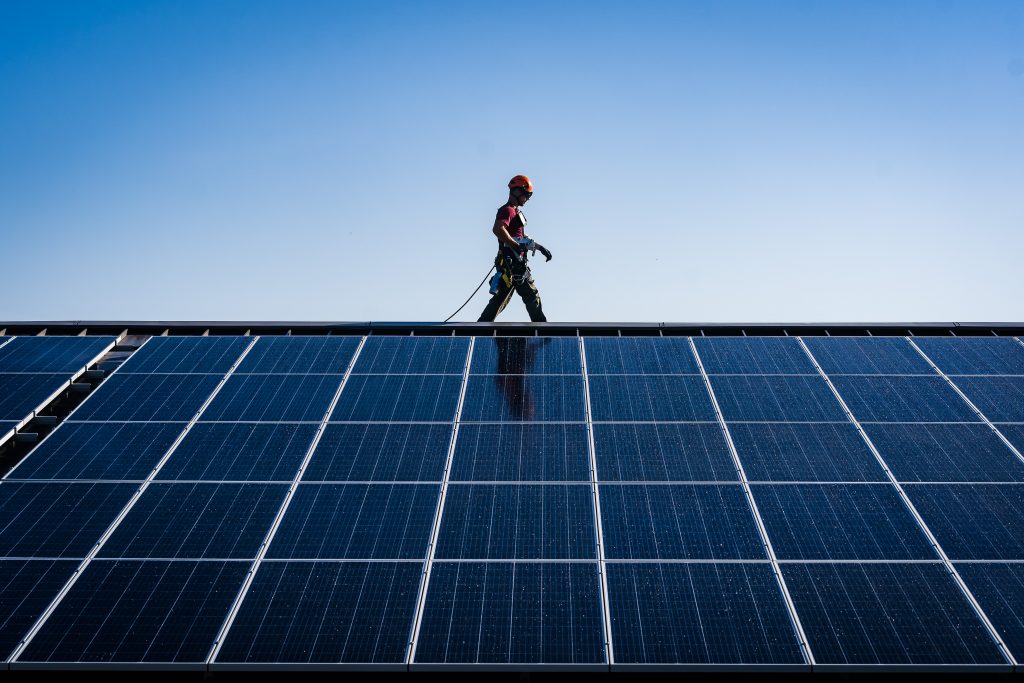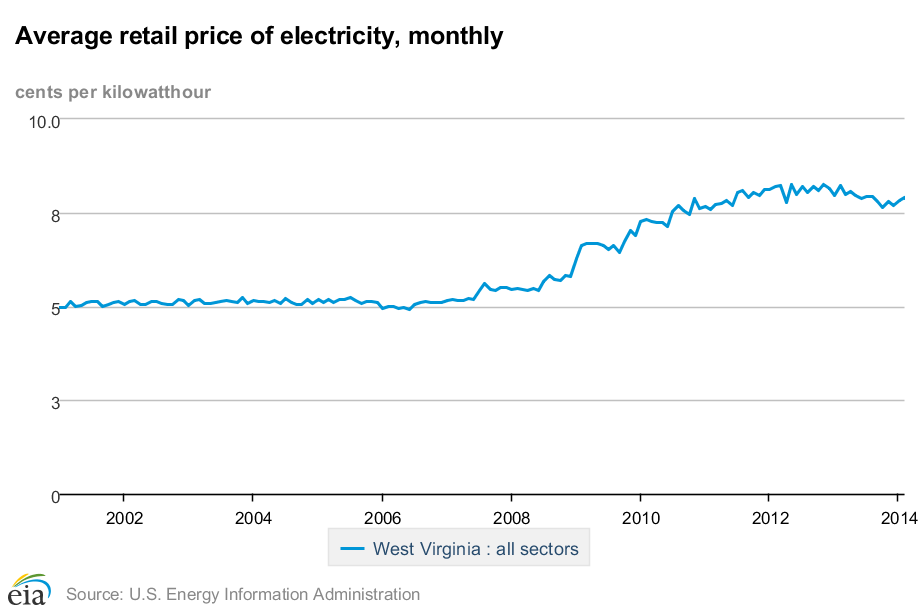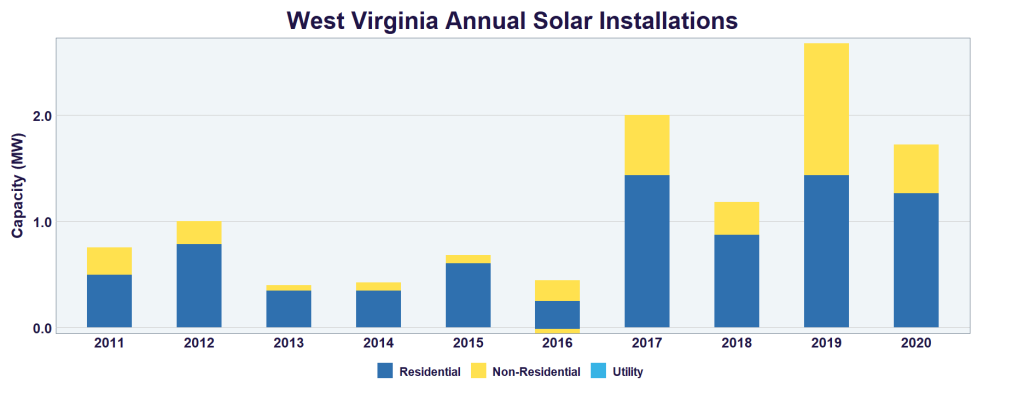Jun 08, 2021
West Virginia Legalizes Solar Power Purchase Agreements

West Virginia has just become the 29th state to allow power purchase agreements for homeowners and commercial electricity customers to get solar power more affordably. It’s a big deal for people who want to see more solar panels and clean energy jobs in the Mountain State.
PPAs ultimately widen access to affordable clean energy, and “states that allow third-party PPAs account for 93% of the increase in American solar capacity since 2015,” according to Solar Power World:
PPAs allow customers to benefit from distributed energy with minimal upfront costs. Customers see electric bill savings from Day 1 and are able to lock in long-term energy rates. This allows them to stabilize their monthly budget expenditures and protect themselves against utility rate increases. West Virginia had the fastest growth rate in electricity prices in the nation between 2008 and 2017.
House Bill 3310 permits PPAs allowing solar customers to install a solar power system on site but not have to pay for solar equipment.
Under a PPA, the solar installer or developer manages the design, permitting, financing and installation of a solar energy system at the customer’s location. Then the solar company continues to own and operate the system on the customer’s behalf. The customer pays only for the energy that the solar panels produce, allowing them to benefit from green energy at a fixed rate that is typically lower than the local utility’s rate.
Controlling Power Costs
In past years across the country, costs for electricity provided by utilities has risen in line with the general rate of inflation with exceptions based on changes in the energy market and of course, geography. Not surprisingly, in West Virginia, more than 92% of the state’s electricity is generated by coal. That led to stable power costs for years, until about 2008, when costs began a steady rise, as seen in the chart below.

Nobody can predict how utility rates will rise in the future. But in West Virginia it’s likely that power from electric utilities will probably get more, rather than less, expensive, as costs increase to generate power from coal. That will make the fixed price that customers pay with a solar PPA more appealing.
In states with the highest utility power rates — Hawaii, California or the Northeast — solar PPAs are popular with both homeowners and commercial power customers. In West Virginia, experts predict that PPAs will be used primarily by commercial-scale solar customers, whether non-taxable schools, colleges and hospitals, or for-profit businesses. Non-taxable organizations have found PPAs attractive in other states because solar companies can tap tax credits and pass the savings along to the non-taxable solar customer.
Our President and Founder Tony Smith worked with a coalition of clean energy and economic development groups that advocated to make PPAs legal in West Virginia. “This legislation tells the world West Virginia is open for business — solar business,” Tony said once the bill passed with bipartisan support in both houses of the state legislature.
The solar industry is the leading job growth sector in the United States, and PPAs will help West Virginia support more solar companies that provide more jobs to more residents. It’s a virtuous cycle. The solar power that those workers install will help attract outside employers, who n turn will create more jobs in the state.
West Virginia Secretary of Commerce Ed Gaunch lauded the legislation for PPAs. In the past, Gaunch has said that more and more large employers are demanding clean energy before they build a facility in the state.
“Particularly what I will call ‘tech-based’ companies — names that you would recognize: Google, Amazon, Facebook — invariably that will be the first or second criteria or question: Where does your state stand in terms of renewables,” Gaunch said. “My feeling is, frankly, we don’t ever make the cut if we can’t answer that question in the affirmative.”
Previously, regulatory barriers to installing solar power kept the state near the bottom when it came to clean energy capacity. West Virginia ranks 50th in the nation in terms of solar power generating capacity installed, sinking from 48th place just last year, not a good trend. The bad news is that solar now provides only 0.03% of West Virginia’s electric power and supports only 311 jobs. The good news is that, with barriers to solar growth removed, West Virginia can follow neighboring states like Maryland (ranked #17) or Virginia (ranked #11) in growing its solar industry. Allowing PPAs is an important step forward.
“Many other states are light years ahead of West Virginia in terms of solar deployment, solar jobs and the market space,” said Autumn Long of Solar United Neighbors, another member of the coalition that advocated for PPAs.
By contrast with those two neighboring states, where electric utilities have played a major role in building solar arrays, in West Virginia, utilities have installed almost no solar power, as the chart below from the Solar Energy Industries Association shows.

“We don’t currently require our utilities to get any percentage of their electricity from renewable resources,” said Long. Passing a mandatory Renewable Portfolio Standard will be key to incentivizing utilities to use clean energy.
Nearly all the solar panels installed in West Virginia so far have been put up at private expense by homeowners and businesses, despite those regulatory barriers that made it more difficult to afford solar power in the past. This shows that the demand for solar has been high, continuing through 2020. Even in a difficult market and during a pandemic, West Virginians deserve a round of applause for stepping up to going green. Now with PPAs legal, going solar will be even more affordable.
Solar Schools in West Virginia
In West Virginia, chief among the tax-exempt entities that could benefit the most from PPAs and going solar are K-12 schools.
“We spoke to several West Virginia public school districts about adding solar power. They really want to save money and improve their curriculum, ” said our President Tony Smith. “Solar PPAs make this possible.”
As they operate on taxpayer-funded budgets that seem to get tighter every year, savings from switching to solar energy can offer welcome budget relief.
For example, the Batesville School District in Arkansas used savings from going solar to increase their teachers’ salaries. Three years after going solar, the school district has saved enough money on its high utility bills to transform the district’s $250,000 budget deficit into a $1.8 million surplus. Tish Tablan of Generation180, co-author of the 2020 Brighter Future report on solar adoption by K-12 schools, noted that 79% of all solar installations on school campuses in America come from PPAs.
So far, K-12 schools in West Virginia have installed 853 kilowatts of solar power, ranking the state #38 nationwide, according to the Brighter Future report, which is much better than the state’s overall ranking for solar. The schools that have gone solar so far deserve credit for their commitment to clean energy, with benefits to the environment, the budget and the curriculum. PPAs will make it possible for other K-12 schools in West Virginia to go solar.
PPAs are especially attractive to schools since they offer a chance to go solar on campus with no upfront cost. Then, generating solar power on campus offers money savings starting on the first day and lasting for twenty years or more into the future.
When schools choose a solar developer like Secure Futures that includes educational programs, teachers can receive standards-compliant classroom materials and teacher training along with more creative offerings like our Throwing Solar Shade® program for citizen science.
An added benefit of putting solar panels on a school’s rooftops can be that the school receives an entirely new roof along with its new solar power system.
To help schools benefit from solar power in more places on campus, Secure Futures offers Resilient Solar + Roof Restoration®. For qualified roofs requiring repairs or facing replacement in the near future, we apply a high-quality roof coating that can extend the life of a roof by decades. And to prove it, we back up all roof restoration work with a warranty for the full period.
See how it works in this video with our customer Doug Arnold of Orange County Schools, a rural school system, on how going solar also helped him deal with a backlog of roof replacement projects.